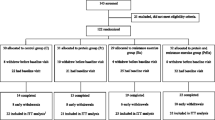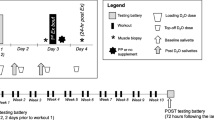Abstract
Objectives
Examine the associations between dietary protein intake, lean mass (LM), and serum myostatin (Mstn) levels among community-dwelling older adults participating in a 20-week high-velocity resistance training (HVRT) program.
Design, Setting, and Participants
This longitudinal study consisted of 33 community-dwelling, older adults (mean age 77.0 years, SD = 6.4); all of which obtained physician clearance prior to study participation.
Measurements
Twenty-five females and eight males were randomized to a control (CON) or HVRT group. Anthropometric measures were obtained via dual energy x-ray absorptiometry (DXA) and peripheral venous blood draw used for serum myostatin analysis. Exercise was performed twice per week for 20 consecutive weeks. Food intake estimation with a diet history questionnaire (DHQ) was used for protein intake comparison to the recommended dietary allowance (RDA). All measures were recorded both prior to and following study participation.
Results
Altogether, protein was consumed in amounts more generous (1.01 ± 0.47 g·kg-1·d-1) than that of the RDA (0.8 g·kg-1·d-1). As a result of significant LM differences among men and women (p < 0.01), additional data were analyzed specific to sex. Serum myostatin was greater among females (6681.8 ± 3155.0 pg·mL-1) than males (5560.0 ± 2946.1 pg·mL-1); however, these values were not significantly different (p = 0.39). Combined, protein consumption and serum myostatin did not significantly influence LM among males (p = 0.09) or females (p = 0.71). Irrespective of training group, significant changes were not exhibited in dietary intake patterns, LM, or serum myostatin.
Conclusions
Contrary to the proposed hypothesis, results suggest protein consumption and circulating serum myostatin levels did not significantly influence LM among older adults. Although HVRT positively impacts LM, neither exercise group displayed significant changes in LM. Therefore, further research is needed examining dietary intake, exercise modality, and myostatin downregulation as non-pharmacological approaches to combating sarcopenia..



Similar content being viewed by others
References
Rosenberg IH. Summary comments. Am J Clin Nutr 1989;50(5):1231–1233.
Hughes VA, Frontera WR, Roubenoff R, Evans WJ, Singh MA. Longitudinal changes in body composition in older men and women: role of body weight change and physical activity. Am J Clin Nutr 2002;76(2):473–481.
Lexell J, Taylor CC, Sjöström M. What is the cause of the ageing atrophy? Total number, size and proportion of different fiber types studied in whole vastus lateralis muscle from 15- to 83-year-old men. J Neurol Sci 1988;84(2–3):275–294.
de Rekeneire N, Visser M, Peila R, Nevitt MC, Cauley JA, Tylavsky FA, Simonsick EM, Harris TB. Is a fall just a fall: Correlates of falling in healthy older persons. The Health, Aging, and Body Composition Study. J Am Geriatr Soc 2003;51(6):841–846.
Baumgartner RN, Koehler KM, Gallagher D, Romero L, Heymsfield SB, Ross RR, Garry PJ, Lindeman RD. Epidemiology of sarcopenia among the elderly in New Mexico. Am J Epidemiol 1998;147(8):755–763.
Janssen I, Heymsfield SB, Ross R. Low relative skeletal muscle mass (sarcopenia) in older persons is associated with functional impairment and physical disability. J Am Geriatr Soc 2002;50(5):889–896.
Melton LJ 3rd, Khosla S, Crowson CS, O’Connor MK, O’Fallon WM, Riggs BL. Epidemiology of sarcopenia. J Am Geriatr Soc 2000;48(6):625–630.
Visser M, Goodpaster BH, Kritchevsky SB, Newman AB, Nevitt M, Rubin SM, Simonsick EM, Harris TB. Muscle mass, muscle strength, and muscle fat infiltration as predictors of incident mobility limitations in well-functioning older persons. J Gerontol A Biol Sci Med Sci 2005;60A(3):324–333.
Lauretani F, Russo CR, Bandinelli S, Bartali B, Cavazzini C, Di Iorio A, Corsi AM, Rantanen T, Guralnik JM, Ferrucci L. Age-associated changes in skeletal muscle and their effect on mobility: an operational diagnosis of sarcopenia. J Appl Physiol 2003;95(5):1851–1860.
Janssen I, Shepard DS, Katzmarzyk PT, Roubenoff R. The healthcare costs of sarcopenia in the United States. J Am Geriatr Soc 2004;52(1):80–85.
Bernstein, M; Munoz N Academy of Nutrition and Dietetics. Position of the Academy of Nutrition and Dietetics: Food and nutrition for older adults: Promoting health and wellness. J Acad Nutr Diet 2012;112(8):1255–1277.
Campbell WW, Trappe TA, Wolfe RR, Evans WJ. The recommended dietary allowance for protein may not be adequate for older people to maintain skeletal muscle. J Gerontol A Biol Sci Med Sci 2001;56A(6):M373–M380.
Wolfe RR, Miller SM, Miller KB. Optimal protein intake in the elderly. Clin Nutr 2008;27(5):675–684.
Baumgartner RN, Waters DL, Gallagher D, Morley JE, Garry PJ. Predictors of skeletal muscle mass in elderly men and women. Mech Ageing Dev 1999;107(2):123–136.
Chodzko-Zajko WJ, Proctor DN, Fiatarone MA, Minson CT, Nigg CR, Salem GJ, Skinner JS. Exercise and physical activity for older adults. Med Sci Sports Exerc 2009;41(7):1510–1530.
Berner LA, Becker G, Wise M, Doi J. Characterization of dietary protein among older adults in the United States: Amount, animal sources, and meal patterns. J Acad Nutr Diet 2013;113(6):809–814.
Trumbo, P., Schlicker, S., Yates, A. A., & Poos, M. (2002). Dietary reference intakes for energy, carbohydrate, fiber, fat, fatty acids, cholesterol, protein and amino acids. J Am Diet Assoc;102(11), 1621–1630.
Campbell WW, Johnson CA, McCabe GP, Carnell NS. Dietary protein requirements of younger and older adults. Am J Clin Nutr 2008;88(5):1322–1329.
Gaffney-Stomberg E, Insogna KL, Rodriguez NR, Kerstetter JE. Increasing dietary protein requirements in elderly people for optimal muscle and bone health. J Am Geriatr Soc 2009;57(6):1073–1079.
Volpi E, Campbell WW, Dwyer JT, Johnson MA, Jensen GL, Morley JE, Wolfe RR. Is the optimal level of protein intake for older adults greater than the recommended dietary allowance? J Gerontol A Biol Sci Med Sci 2013;68(6):677–681.
Scott D, Blizzard L, Fell J, Giles G, Jones G. Associations between dietary nutrient intake and muscle mass and strength in community-dwelling older adults: The Tasmanian Older Adult Cohort Study. J Am Geriatr Soc 2010;58(11):2129–2134.
Houston DK, Nicklas BJ, Ding J, Harris TB, Tylavsky FA, Newman AB, Lee SJ, Sahyoun NR, Visser M, Kritchevsky SB. Dietary protein intake is associated with lean mass change in older, community-dwelling adults: the Health, Aging, and Body Composition (Health ABC) Study. Am J Clin Nutr 2008;87(1):150–155.
Geirsdottir OG, Arnarson A, Ramel A, Jonsson PV, Thorsdottir I. Dietary protein intake is associated with lean body mass in community-dwelling older adults. Nutr Res 2013;33(8):608–612.
Van Til, A. J., Naumann, E., Cox-Claessens, I. J. H. M., Kremer, S., Boelsma, E., & de van der Schueren, M. A. Effects of the daily consumption of protein enriched bread and protein enriched drinking yoghurt on the total protein intake in older adults in a rehabilitation centre: A single blind randomised controlled trial. The J Nutr, Health Aging, 2015;19(5), 525–530.
Bauer J, Biolo G, Cederholm T, Cesari M, Cruz-Jentoft AJ, Morley JE, Phillips S, Sieber C, Stehle P, Teta D, Visvanathan R, Volpi E, Boirie Y. Evidence-based recommendations for optimal dietary protein intake in older people: A position paper from the PROT-AGE study group. J Am Med Dir Assoc 2013;14(8):542–559.
Morais JA, Chevalier S, Gougeon R. Protein turnover and requirements in the healthy and frail elderly. J Nutr Health Aging 2006;10(4):272–283.
Frontera WR, Meredith CN, O’Reilly KP, Knuttgen HG, Evans WJ. Strength conditioning in older men: skeletal muscle hypertrophy and improved function. J Appl Physiol 1988;64(3):1038–1044.
Taaffe DR, Duret C, Wheeler S, Marcus R. Once-weekly resistance exercise improves muscular strength and neuromuscular function in older adults. J Am Geriatr Soc 1999;47(10):1208–1214.
Trappe S, Williamson D, Godard M, Porter D, Rowden G, Costill D. Effect of resistance training on single muscle fiber contractile function in older men. J Appl Physiol 2000;89(1):143–152.
Fielding RA, LeBrasseur NK, Cuoco A, Bean J, Mizer K, Singh MAF. High-velocity resistance training increases skeletal muscle peak power in older women. J Am Geriatr Soc 2002;50(4):655–662.
Henwood TR, Taaffe DR. Improved physical performance in older adults undertaking a short-term programme of high-velocity resistance training. Gerontology 2005;51(2):108–115.
Miszko TA, Cress ME, Slade JM, Covey CJ, Agrawal SK, Doerr CE. Effect of strength and power training on physical function in community-dwelling older adults. J Gerontol A Biol Sci Med Sci 2003;58A(2):171–175.
Sayers SP. High-speed power training: A novel approach to resistance training in older men and women. A brief review and pilot study. J Strength Cond Res 2007;21(2):518–526.
Henwood TR, Riek S, Taaffe DR. Strength versus muscle power-specific resistance training in community-dwelling older adults. J Gerontol A Biol Sci Med Sci 2008;63A(1):83–91.
Hulmi JJ, Tannerstedt J, Selänne H, Kainulainen H, Kovanen V, Mero AA. Resistance exercise with whey protein ingestion affects mTOR signaling pathway and myostatin in men. J Appl Physiol 2009;106(5):1720–1729.
Sandri, M., Barberi, L., Bijlsma, A. Y., Blaauw, B., Dyar, K. A., Milan, G.,... & Pion, D. Signalling pathways regulating muscle mass in ageing skeletal muscle. The role of the IGF1-Akt-mTOR-FoxO pathway. Biogerontology, 2013;14(3), 303–323.
Joulia-Ekaza, D. & Cabello, G. The myostatin gene: Physiology and pharmacological relevance. Curr Opin in Pharmacolog 2007;7, 310–315.
Kawada, S., Tachi, C., & Ishii, N. Content and localization of myostatin in mouse skeletal muscles during aging, mechanical unloading and reloading. J Muscle Res Cell Motil 2001;22, 627–633.
Kim, J., Cross, J.M., Bamman, M.M. Impact of resistance loading on myostatin expression and cell cycle regulation in young and older men and women. Am J Physiol Endocrinol Metab 2005;288, E1110–E1119. doi: 10.1152/ajpendo.00464.2004
LeBrasseur, N.K., Shelhorn, T.M., Bernardo, B.L., Cosgrove, P.G., Loria, P.M., & Brown, T.A. Myostatin inhibition enhances the effects of exercise on performance and metabolic outcomes in aged mice. J Gerontol Sci 2009;64A(9), 940–948.
Fiatarone MA, O’Neill EF, Ryan ND, Clements KM, Solares GR, Nelson ME, Roberts SB, Kehayias JJ, Lipsitz LA, Evans WJ. Exercise training and nutritional supplementation for physical frailty in very elderly people. New Engl J Med 1994;330(25):1769–1775.
Folstein MF, Folstein SE, McHugh PR. Mini-mental state: A practical method for grading the cognitive state of patients for the clinician. J Psychiatr Res 1975;12(3):189–198.
Subar AF, Thompson FE, Kipnis V, Midthune D, Hurwitz P, McNutt S, McIntosh A, Rosenfeld S. Comparative validation of the Block, Willett, and National Cancer Institute food frequency questionnaires. Am J Epidemiol 2001;154(12):1089–1099.
Pasiakos, S.M., Agarwal, S., Lieberman, H.R., & Fulgoni III, V.L. Sources and amounts of animal, dairy, and plant protein intake of US adults in 2007-2010. Nutrients 2015;7, 7058–7069. doi: 10.3390/nu7085322
Yarasheski KE, Bhasin S, Sinha-Hikim I, Pak-Loduca J, Gonzalez-Cadavid NF. Serum myostatin-immunoreactive protein is increased in 60-92 year old women and men with muscle wasting. J Nutr Health Aging 2002;6(5):343–348.
Lee SJ. Regulation of muscle mass by myostatin. Annu Rev Cell Dev Biol 2004;20(1):61–86.
Author information
Authors and Affiliations
Corresponding author
Rights and permissions
About this article
Cite this article
Binns, A., Gray, M., Henson, A.C. et al. Changes in lean mass and serum myostatin with habitual protein intake and high-velocity resistance training. J Nutr Health Aging 21, 1111–1117 (2017). https://doi.org/10.1007/s12603-017-0883-6
Received:
Accepted:
Published:
Issue Date:
DOI: https://doi.org/10.1007/s12603-017-0883-6




